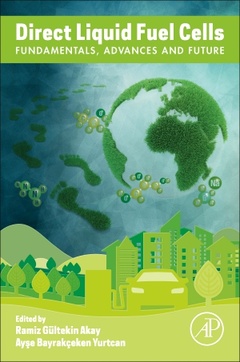Direct Liquid Fuel Cells Fundamentals, Advances and Future
Coordonnateurs : Akay Ramiz Gültekin, Yurtcan Ayşe Bayrakçeken

Direct Liquid Fuel Cells is a comprehensive overview of the fundamentals and specificities of the use of methanol, ethanol, glycerol, formic acid and formate, dimethyl ether, borohydride, hydrazine and other promising liquid fuels in fuel cells. Each chapter covers a different liquid fuel-based fuel cell such as: Anode catalysts of direct methanol fuel cells (DMFCs), future system designs and future trends for direct ethanol fuel cells (DEFCs), development of catalysts for direct glycerol fuel cells (DGFCs), the mechanisms of the reactions taking place at the anode and cathode electrodes, and the reported anode catalysts for direct formic acid fuel cell (DFAFC) and direct formate fuel cell (DFFC), characteristics of direct dimethyl ether fuel cell (DDMEFC), including its electrochemical and operating systems and design, the developments in direct borohydride fuel cells, the development of catalysts for direct hydrazine fuel cells (DHFCs), and also the uncommonly used liquids that have a potential for fuel cell applications including 2-propanol, ethylene glycol, ascorbic acid and ascorbate studied in the literature as well as utilization of some blended fuels. In each part, the most recent literature is reviewed and the state of the art is presented. It also includes examples of practical problems with solutions and a summarized comparison of performance, advantages, and limitations of each type of fuel cell discussed. Direct Liquid Fuel Cells is not a typical textbook but rather designed as a reference book of which any level of students (undergraduate or graduate), instructors, field specialists, industry and general audience, who benefit from current and complete understanding of the many aspects involved in the development and operation of these types of fuel cells, could make use of any chapter when necessary.
1. Introduction to fuel cells 2. Introduction to direct alcohol fuel cells (DAFCs) 3. Direct methanol fuel cells (DMFCs) 4. Direct ethanol fuel cells (DEFCs) 5. Direct glycerol fuel cells (DGFCs) 6. Introduction to other organic fuel-based fuel cells 7. Direct formic acid and formate fuel cells (DF(A)FCs) 8. Direct dimethyl ether fuel cells (DDMEFCs) 9. Introduction to inorganic fuel-based direct liquid fuel cells 10. Direct borohydride fuel cells (DBFCs) 11. Direct hydrazine fuel cells (DHFCs) 12. Other possible fuels and possible use of blended fuels in fuel cells 13. Conclusions: Current state and future
Researchers in academia and industry, and practitioners in the fuel cell energy and fuel cell transportation sectors. Graduate students and early-career researchers starting their research in direct liquid fuel cells development and optimization.
Ayse Bayrakçeken Yurtcan is a professor of Chemical Engineering in the Department of Chemical Engineering at Atatürk University, Turkey. Her research focuses on electrocatalysts for fuel cells, carbon-based nanomaterials, nanomaterials for energy, and material characterization.
- Presents information on different types of direct liquid fuel cells.
- Explores information under each section, for specific fuel-based fuel cells in more detail in terms of the materials used.
- Covers three main sections: direct alcohol, organic fuel-based and inorganic fuel-based fuel cells
Date de parution : 09-2020
Ouvrage de 328 p.
15x22.8 cm
Thème de Direct Liquid Fuel Cells :
Mots-clés :
Direct glycerol fuel cells (DGFC); Direct borohdride Fuel Cells (DBFC); Direct Hydrazine Fuel Cells (DHFC); Direct Formic Acid Fuel Cells (DFAFC); Direct Ammonia Borane Fuel Cells (DABFC); electrocatalysts for fuel cells; alkaline fuel cells; anion exchange membranes; cation exchange membranes; polymer electrolyte membranes; clean electricity production; low temperature fuel cells



